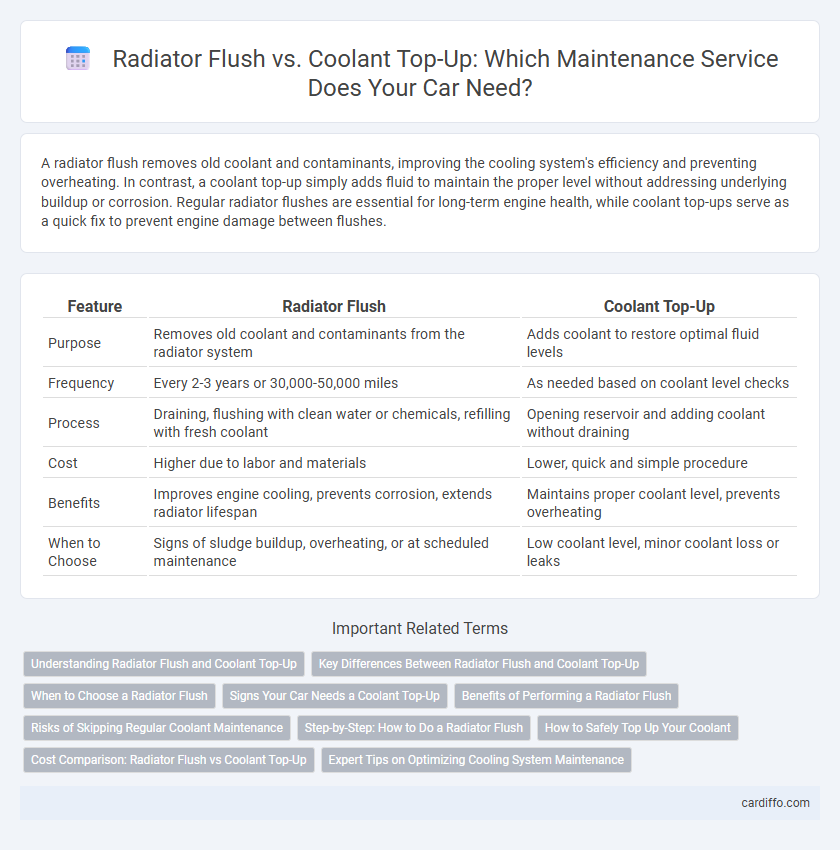A radiator flush removes old coolant and contaminants, improving the cooling system's efficiency and preventing overheating. In contrast, a coolant top-up simply adds fluid to maintain the proper level without addressing underlying buildup or corrosion. Regular radiator flushes are essential for long-term engine health, while coolant top-ups serve as a quick fix to prevent engine damage between flushes.
Table of Comparison
| Feature | Radiator Flush | Coolant Top-Up |
|---|---|---|
| Purpose | Removes old coolant and contaminants from the radiator system | Adds coolant to restore optimal fluid levels |
| Frequency | Every 2-3 years or 30,000-50,000 miles | As needed based on coolant level checks |
| Process | Draining, flushing with clean water or chemicals, refilling with fresh coolant | Opening reservoir and adding coolant without draining |
| Cost | Higher due to labor and materials | Lower, quick and simple procedure |
| Benefits | Improves engine cooling, prevents corrosion, extends radiator lifespan | Maintains proper coolant level, prevents overheating |
| When to Choose | Signs of sludge buildup, overheating, or at scheduled maintenance | Low coolant level, minor coolant loss or leaks |
Understanding Radiator Flush and Coolant Top-Up
Radiator flush involves draining and cleaning the entire cooling system to remove debris, rust, and old coolant, ensuring optimal engine temperature regulation and preventing overheating. Coolant top-up simply replenishes the coolant level without addressing contamination or sediment buildup, offering a temporary solution for minor fluid loss. Regular radiator flushes enhance cooling efficiency and prolong engine life, whereas coolant top-ups maintain fluid levels between flushes.
Key Differences Between Radiator Flush and Coolant Top-Up
Radiator flush involves completely draining and cleaning the cooling system to remove rust, debris, and old coolant, ensuring optimal heat dissipation and preventing engine overheating. Coolant top-up simply adds fresh coolant to maintain the proper fluid level, addressing minor losses without addressing contamination or sludge buildup. Radiator flush is a more thorough maintenance procedure recommended periodically, while coolant top-up is a routine task to maintain performance between flushes.
When to Choose a Radiator Flush
Choose a radiator flush when the cooling system shows signs of sludge buildup, corrosion, or overheating, as it thoroughly removes contaminants that coolant top-ups cannot address. Radiator flushes are essential every 30,000 to 50,000 miles or as recommended by the vehicle manufacturer to maintain optimal engine temperature regulation. Coolant top-up is suitable for minor fluid losses but does not replace the flushing process required to restore radiator efficiency and prevent costly engine damage.
Signs Your Car Needs a Coolant Top-Up
Low coolant levels often cause engine overheating and a constantly rising temperature gauge, signaling the need for a coolant top-up. Persistent coolant leaks under the vehicle or visible coolant stains around the radiator cap indicate fluid loss requiring immediate replenishment. Warning lights on the dashboard, such as the temperature or check engine light, are critical alerts that the coolant system needs attention to prevent engine damage.
Benefits of Performing a Radiator Flush
Performing a radiator flush removes accumulated rust, sediment, and contaminants that can clog the cooling system, ensuring optimal heat transfer and preventing engine overheating. Unlike simple coolant top-ups, a flush restores the radiator's efficiency by completely renewing the coolant, which extends the lifespan of the radiator, thermostat, and water pump. This maintenance reduces the risk of costly repairs and maintains consistent engine performance, especially in extreme temperature conditions.
Risks of Skipping Regular Coolant Maintenance
Skipping regular coolant maintenance, including radiator flushes and coolant top-ups, significantly increases the risk of engine overheating and corrosion within the cooling system. Stagnant or degraded coolant loses its ability to regulate temperature effectively and protect metal components from rust and sediment buildup. Neglecting these essential services can lead to costly engine repairs, reduced fuel efficiency, and premature radiator failure.
Step-by-Step: How to Do a Radiator Flush
Drain the old coolant by locating the radiator drain plug and opening it carefully to avoid spills. Close the drain plug, fill the radiator with a radiator flush solution mixed with water, then run the engine for 10-15 minutes with the heater on full to circulate the solution. Afterward, drain the flush mixture, refill the radiator with fresh coolant, and bleed the system to remove air pockets for optimal cooling performance.
How to Safely Top Up Your Coolant
Safely topping up your coolant involves first allowing the engine to cool completely to prevent burns from hot fluid or steam. Use a recommended coolant type specified by the vehicle manufacturer, and slowly add it to the radiator or coolant reservoir until reaching the proper level marked by the minimum and maximum indicators. Always tighten the cap securely after topping up and check for leaks to maintain optimal engine temperature and prevent overheating.
Cost Comparison: Radiator Flush vs Coolant Top-Up
Radiator flush procedures typically cost between $70 and $120, reflecting the thorough cleaning and replacement of old coolant, whereas coolant top-up services range from $20 to $50, involving only the addition of fluid to maintain optimal levels. While radiator flushes offer comprehensive maintenance to prevent overheating and corrosion, they are more expensive due to labor and disposal of contaminated coolant. Coolant top-ups provide a budget-friendly option for quick fluid replenishment but may not address underlying radiator system issues.
Expert Tips on Optimizing Cooling System Maintenance
Performing a radiator flush removes accumulated rust, scale, and contaminants, ensuring optimal heat dissipation and preventing engine overheating more effectively than a simple coolant top-up. Regular flushing every 30,000 to 50,000 miles, combined with using manufacturer-recommended coolant, maximizes thermal efficiency and extends radiator lifespan. Expert maintenance protocols emphasize flushing for complete system cleanliness, reserving coolant top-ups for minor fluid level adjustments between service intervals.
Radiator flush vs Coolant top-up Infographic

 cardiffo.com
cardiffo.com